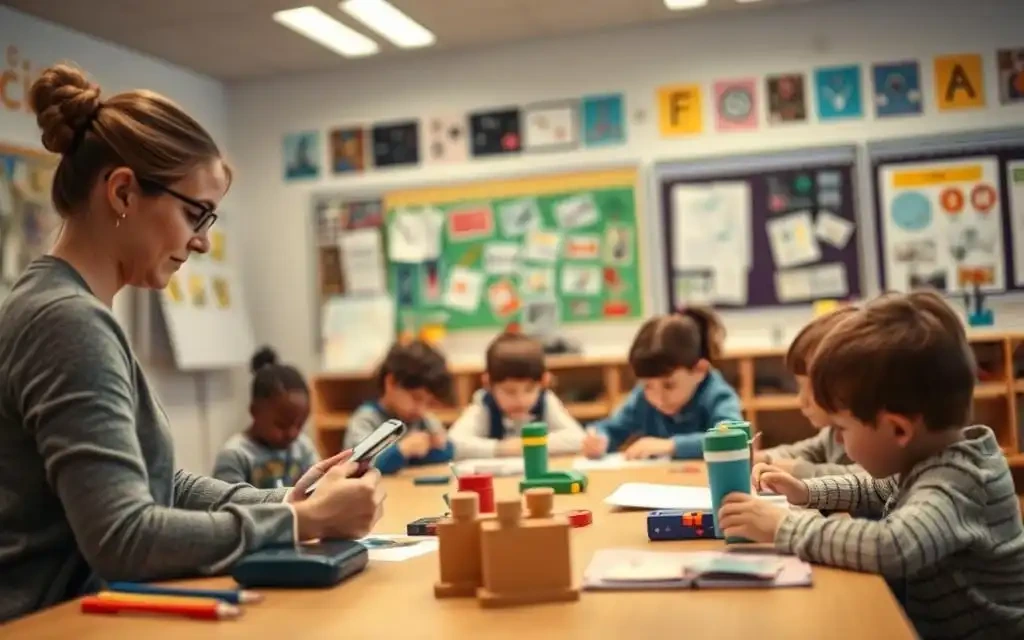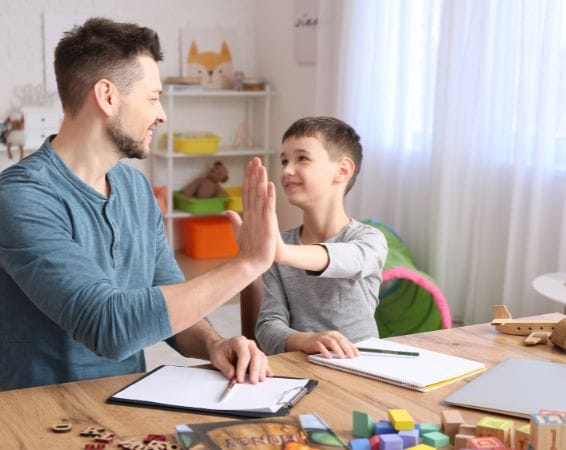Dealing with special education can be tough for parents. Homeschooling special needs students lets you make learning fit your child’s needs. With the right plan and support, you can help your child succeed in school.
Every child with special needs learns differently. Homeschooling lets you change how and when you teach. This way, your child gets the attention and help they need, more than in a regular classroom.
Knowing what your child needs to learn is key. By using their strengths and helping with their challenges, you can make learning fun and supportive. This helps them grow both in school and as a person.
Table of Contents
Key Takeaways
- Personalized learning experiences are essential for special needs students
- Homeschooling offers unique flexibility in educational approaches
- Individual attention can significantly improve learning outcomes
- Tailored special education curriculum supports diverse learning styles
- Parents play a critical role in special needs education
Understanding Special Needs Education at Home
Learning about special needs education is key. Parents are vital in helping kids with learning disabilities and neurodiversity. They do this by making learning at home fit each child’s needs.
Every child learns in their own way, especially those with special needs. It’s important to see and accept these differences. This is the first step to making learning work for them.
Identifying Learning Styles and Challenges
Knowing how your child learns is crucial for home education. Kids with learning disabilities have unique strengths and challenges. They need special approaches to learn best:
- Visual learners do well with pictures and charts
- Auditory learners get it through listening
- Kinesthetic learners learn by doing
Assessing Your Child’s Educational Needs
Getting a full understanding of your child’s needs is essential. Work with experts to get a detailed picture of what they need to learn.
| Assessment Area | Key Considerations |
|---|---|
| Cognitive Skills | Evaluate processing speed, memory, and reasoning |
| Academic Performance | Identify specific subject strengths and challenges |
| Emotional Regulation | Understand sensory processing and emotional responses |
Creating a Supportive Learning Environment
Make your home a great place for learning with strategic educational accommodations. Aim for a calm, organized space. This helps reduce distractions and meets your child’s learning needs.
- Establish consistent routines
- Use sensory-friendly materials
- Provide frequent positive reinforcement
Accepting neurodiversity means celebrating your child’s unique learning path. It’s about giving them the support they need to succeed.
Legal Requirements for Homeschooling Special Needs Children
Understanding the laws for homeschooling special needs kids can be tough. Each state in the U.S. has its own rules for homeschooling these students. It’s very important to know what your state requires.
When you think about homeschooling special needs kids, you’ll face some important legal issues:
- Notification and registration with local school districts
- Documenting educational progress
- Meeting state-specific assessment requirements
- Maintaining comprehensive educational records
How well you follow the law depends on your state’s homeschooling rules. Some states need more detailed records for special needs kids. Others are more flexible.
| State Category | Notification Requirements | Assessment Mandate |
|---|---|---|
| Low Regulation States | Minimal paperwork | Annual progress report |
| Moderate Regulation States | Parent qualification review | Standardized testing |
| High Regulation States | Detailed curriculum submission | Professional evaluation required |
To homeschool special needs kids well, you need to know the laws. Doing your homework and talking to local schools is key. This way, you can create a good learning space at home.
Essential Tools and Resources for Special Needs Homeschooling
Special needs homeschooling needs careful planning and the right tools. Parents can make homeschooling better for their kids with special needs. They can use new tools and get help from support groups.
Choosing the right resources can really help your child learn. There are now many autism homeschool curriculums. They help kids learn in ways that fit their needs.
Adaptive Technology and Learning Aids
- Assistive communication devices
- Sensory integration tools
- Specialized learning software
- Adaptive learning platforms
Curriculum Materials and Educational Software
Looking for the best autism homeschool curriculum takes time. You need to know what your child needs. Today’s tech offers learning that’s just for them.
| Curriculum Type | Key Features | Recommended Age Group |
|---|---|---|
| Visual Learning Curriculum | Picture-based instruction | 5-12 years |
| Interactive Digital Programs | Adaptive learning paths | 8-16 years |
| Multisensory Learning Systems | Tactile and auditory support | 3-10 years |
Therapeutic Resources and Support Services
Adding therapy to homeschool helps your child grow. Online therapy, counseling, and support groups are great help.
- Virtual therapy sessions
- Professional consultation services
- Parent training workshops
- Community support networks
Remember, every child is different. Keep checking and changing your resources as your child grows.
Creating an Individualized Education Plan (IEP) at Home
Creating a special education curriculum for your child needs careful planning. An Individualized Education Plan (IEP) is like a roadmap for their learning. It makes learning fit their unique needs and strengths.
When making an IEP at home, think about these important parts:
- Comprehensive assessment of your child’s current academic and developmental levels
- Specific, measurable learning goals
- Clear educational accommodations
- Strategies for tracking progress
Your IEP should detail your child’s learning style, challenges, and strengths. Make sure the goals are realistic and help build confidence and skills. Educational accommodations are key to supporting your child’s learning.
Here are the main steps for a successful home-based IEP:
- Conduct a comprehensive skills assessment
- Set SMART goals (Specific, Measurable, Achievable, Relevant, Time-bound)
- Design flexible learning strategies
- Implement regular progress monitoring
- Adjust the plan as needed
Remember, your special education curriculum is a living document. Keep reviewing and updating the IEP to meet your child’s changing needs. This ensures their unique learning journey is supported.
Developing a Daily Schedule and Routine
Creating a daily routine is key when homeschooling a child with autism. It helps reduce anxiety and makes learning more effective. Your homeschooling plan should mix academic learning with activities that help your child’s special needs.
Good strategies for homeschooling a child with autism need a consistent schedule. Each child with autism learns differently and has unique needs. They need a plan that fits their learning style and sensory sensitivities.
Balancing Academic and Therapeutic Activities
When making a homeschooling plan for an autistic child, remember these important points:
- Create a visual schedule with clear time blocks
- Alternate between academic and therapeutic activities
- Use timers to signal transition between tasks
- Incorporate frequent short breaks
Incorporating Sensory Breaks
Sensory breaks are vital for children with autism. They help manage their emotions and physical state. Structured movement activities keep focus and prevent feeling overwhelmed during lessons.
- Design 5-10 minute sensory break intervals
- Include stretching exercises
- Use weighted blankets
- Provide quiet reflection spaces
Managing Time Effectively
Managing time well in homeschooling means being flexible and patient. Use visual timers, color-coded schedules, and rewards to help your child stick to the routine.
A well-structured routine transforms learning challenges into opportunities for growth and understanding.
Adapting Curriculum for Different Learning Disabilities

Creating a special education curriculum needs a deep understanding of each student’s learning disabilities. Every student faces unique challenges that require a tailored educational plan. By adapting your teaching methods, you can greatly enhance your child’s learning journey.
Important strategies for changing the curriculum include:
- Identifying specific learning strengths and challenges
- Breaking complex tasks into smaller, manageable steps
- Using multi-sensory instructional techniques
- Incorporating visual and interactive learning materials
When dealing with learning disabilities, consider these specific adaptation techniques:
- Dyslexia: Use audiobooks, color-coded text, and phonetic learning tools
- ADHD: Implement shorter lesson segments with frequent breaks
- Autism Spectrum: Create structured, predictable learning environments
Technology is vital in supporting students with learning disabilities. Digital tools offer adaptive learning experiences tailored to individual needs. Screen readers, speech-to-text software, and interactive educational apps provide extra support in your special education curriculum.
Remember, being flexible is crucial. Regularly check your child’s progress and be ready to make changes. Working with educational specialists can offer valuable insights into making your curriculum more effective.
Building Social Skills Through Homeschooling Special Needs
Homeschooling special needs children needs a careful plan for social skills. Neurodiversity makes social interactions hard, so it’s key to focus on building these skills. This helps kids grow and feel more confident.
Social skills are very important for kids with special needs. They help with talking and making friends. Parents can make social experiences meaningful by planning and being creative.
Community Integration Strategies
- Join local homeschool support groups for neurodiversity
- Take part in adaptive recreational programs
- Go to inclusive community events
- Do volunteer work that your child likes
Peer Interaction Opportunities
Structured social interactions are key for kids with special needs. They help with communication skills. Here are some ideas:
- Set up small group learning sessions
- Arrange supervised playdates
- Use online social skills workshops
- Join special needs sports leagues
Social Skills Development Activities
| Activity Type | Skills Developed | Recommended Frequency |
|---|---|---|
| Role-playing scenarios | Communication, empathy | Weekly |
| Group board game sessions | Turn-taking, cooperation | Bi-weekly |
| Drama/improv workshops | Emotional recognition, interaction | Monthly |
Using these strategies, you can make a supportive space. It helps with social skills and respects your child’s unique needs.
Tracking Progress and Measuring Success
![]()
Keeping an eye on your child’s growth in special education is key. It’s not just about grades. It’s about seeing how they do in their own way.
There are many ways to track progress:
- Set clear goals that are achievable
- Keep a record of their skills
- Try different ways to check their progress
- Always celebrate their small wins
As a homeschool parent, you need to be flexible. Qualitative observations are just as important as numbers when it comes to seeing how special needs students grow.
| Assessment Area | Tracking Method | Frequency |
|---|---|---|
| Academic Skills | Portfolio Review | Quarterly |
| Social Development | Interaction Logs | Monthly |
| Life Skills | Skill Checklist | Bi-Annually |
Remember, progress isn’t always straight. Being flexible in your teaching helps make learning special and personal for your child.
Working with Therapists and Educational Specialists
Special needs education is complex. Homeschooling a child with special needs needs a strong support network. This network is key for a good learning environment.
Good homeschool support groups value professional partnerships. Your child’s education improves with the help of experts and coordinated services.
Coordinating Professional Services
Effective service coordination means planning and clear talks. Here are some important steps:
- Schedule regular meetings with specialists
- Keep detailed records of progress
- Use flexible strategies for help
- Use online tools for communication
Implementing Professional Recommendations
Turning expert advice into homeschool plans needs careful thought. Use special needs resources to create plans that fit your child’s needs.
| Specialist Type | Recommended Integration | Goal |
|---|---|---|
| Speech Therapist | Daily communication exercises | Language skill development |
| Occupational Therapist | Adaptive learning techniques | Motor skill improvement |
| Behavioral Specialist | Structured routine implementation | Emotional regulation |
Building a Comprehensive Support Team
Your support team should have different professionals who know your child’s needs. Look for specialists who:
- Know a lot about special needs education
- Are flexible in their methods
- Talk clearly and with kindness
- Keep learning and growing
Remember, working together is crucial for a great education for your special needs child.
Managing Challenges and Overcoming Obstacles
Homeschooling special needs children comes with big challenges. Parents face tough emotional and educational hurdles. Knowing these challenges helps in finding ways to succeed.
Some common hurdles include:
- Emotional exhaustion and burnout
- Dealing with behavioral issues
- Changing curriculum for each child’s needs
- Keeping up motivation
Managing behavior needs patience and special methods. Consistent routines and clear rules make kids with learning disabilities feel safe. Finding personal ways to handle tough times can lead to growth.
Ways to beat homeschooling hurdles are:
- Make learning spaces flexible
- Practice self-care regularly
- Get help from experts
- Use tech to adapt learning
| Challenge | Potential Solution |
|---|---|
| Emotional Burnout | Schedule regular breaks, join support groups |
| Learning Plateaus | Reassess educational strategies, consult specialists |
| Motivation Challenges | Use reward systems, personalized goal setting |
Every problem is a chance to grow. Your dedication to homeschooling special needs kids can lead to amazing learning experiences. These might not be possible in regular schools.
Supporting Parents and Caregivers
Homeschooling a special needs child is very demanding. It takes a lot of emotional and physical energy. Taking care of yourself is key to being a good teacher and caregiver.
Joining homeschool support groups can really help. These groups offer support, advice, and understanding. They are great for sharing experiences and learning new teaching methods.
It’s also important to keep learning. Online workshops and training programs can teach you new ways to help your child. Organizations like the National Association of Special Education Teachers provide valuable resources and training.
Don’t think asking for help is a weakness. It’s a smart way to give your child the best education. Make time for yourself, join support groups, and take breaks when you need them.
Read also our post: All Autistic People Are Introverted : Myth or Truth?
FAQ
What are the legal requirements for homeschooling a special needs child?
How do I create an Individualized Education Plan (IEP) for homeschooling?
What curriculum works best for children with autism?
How can I ensure my special needs child receives proper socialization?
What resources are available for homeschooling special needs students?
How do I manage my own stress while homeschooling a special needs child?
Can I receive financial assistance for homeschooling a special needs child?
What adaptive technologies can help in homeschooling?

